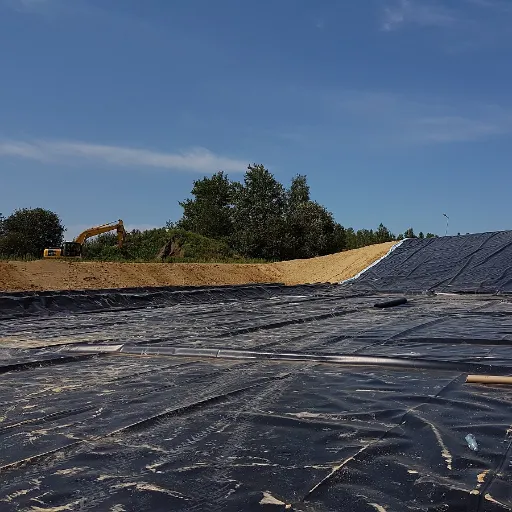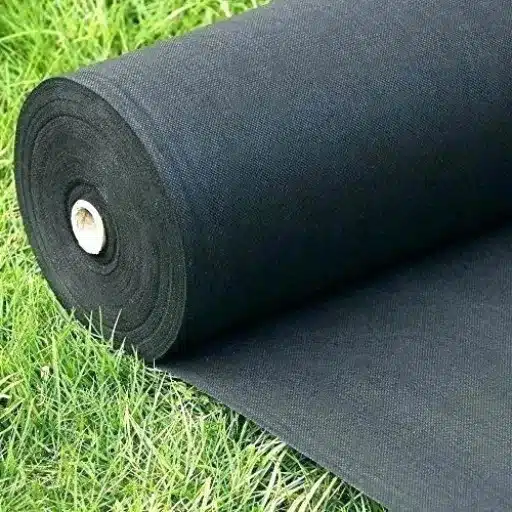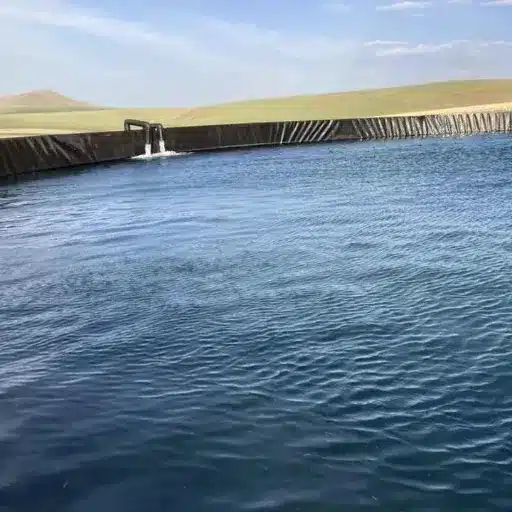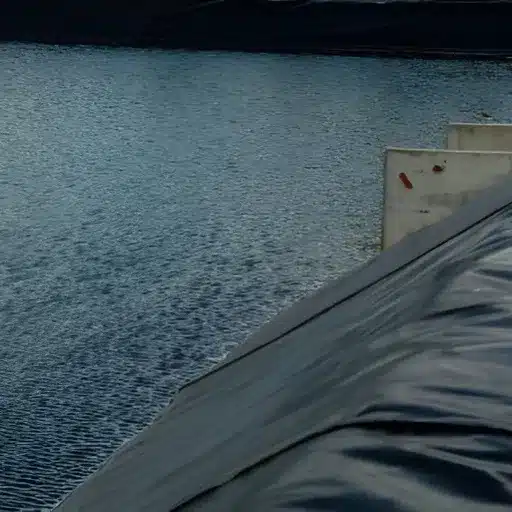The use of geosynthetics is indispensable in the modern era of engineering and construction, as they provide ingenious ways to solve issues related to soil stabilization, erosion control, and environmental protection. Out of the various types of geosynthetics, geotextiles and geomembranes unambiguously emerge as two distinct and necessary materials, each having its own specific and diverse application areas. However, the first question is, what exactly differentiates them, and next, how one can tell which one is the best for their particular project? The purpose of this article is to clear up the confusion between geotextiles and geomembranes through an examination of their properties, purposes, and particular instances of application. Thus, you will eventually comprehend the role of these materials in the development of infrastructure that is both environmentally friendly and highly functional.
Introduction to Geosynthetics

The role of Geosynthetics in Modern Engineering
Geosynthetics have become an essential element of modern engineering thanks to their range of applications, durability, and economic value. These materials comprise geotextiles, geomembranes, geogrids, and geocomposites, and have changed the way building sites are developed and operated by providing new ways to deal with their intricacies. Heaps of geosynthetics are applied in the fields of soil stabilization, erosion control, waste management, and handling of water.
Among others these materials give infrastructures the longer life and the better stability as the major contribution. For instance, geotextiles are frequently used to stop soil erosion and to make the foundations more solidly placed, while geomembranes are the ones that provide landfills with the leakage-proof and the very same time water protection from contamination. It is reported by researchers that the lifespan of highways and roads could be lengthened by 50% when the use of reinforcement layers of geosynthetics is the case, thus, the expenses for maintenance are lessening and the security is consequently improved.
Introduction to Geotextiles and Geomembranes
Geotextiles and geomembranes represent two fundamental types of geosynthetics that are extensively incorporated in engineering and environmental applications. Geotextiles can be characterized as permeable fabrics that are produced from polymeric substances such as polypropylene or polyester. They mainly serve in soil reinforcement, separation, filtration, and drainage activities in building sites. Conversely, geomembranes can be denoted as non-permeable synthetic membranes with the purpose of containment and barring, and they are very much applicable in waste processing, water reservoirs, and mining activities, among others.
Market Insight: Geotextile demand across the globe is on an upward trend with an array of applications that include the construction of roads, prevention of soil erosion, and reclamation of land. According to the latest report, the market for geotextiles was estimated to be around US$ 9.5 billion in 2022 and is projected to witness a CAGR of 10-12% between 2023 and 2030. The primary factors contributing to the market growth are the increased investments in infrastructure and the awareness of eco-friendly practices in the construction industry.
Material Composition

What is a Geotextile?
Geotextiles are ground- and water-permeable fabrics, which are used in geotechnics and environmental engineering to improve the characteristics of the soil by reinforcing, separating, filtering, protecting, or draining it. The geotextiles are made of polymers like polypropylene and polyester, and they are very strong and durable as they are tailor-made for the application’s demands. The main purpose of geotextiles is to support and enhance the performance of the soils in the long run in construction projects.
Types of Geotextiles:
- Woven geotextiles: Created by interlacing the threads to form a strong and durable fabric that can be used for load distribution and erosion control.
- Non-woven geotextiles: Made by using bonding techniques such as heat and chemical treatment and they are very good at filtration and drainage.
- Knitted geotextiles: Not so common but they are produced using knitting technology and they have a unique feature of flexibility.
What is a Geomembrane?
A geomembrane is a synthetic membrane liner or barrier with a very low permeability and it is mostly used in geotechnical engineering as a method of controlling the migration of fluids or gases in the installations. The membranes are made of polymeric materials like high-density polyethylene (HDPE), linear low-density polyethylene (LLDPE), polypropylene (PP), or polyvinyl chloride (PVC). The membrane’s main function is to be a barrier layer, giving high resistance to chemical degradation and environmental factors such as UV light, which makes them suitable for even the most challenging applications.
Geomembranes are used in many different industries like waste management, mining, agriculture, and water resources. For instance, in a landfill site, geomembranes are the parts of liner systems that are most critical because they prevent the leakage of contaminated water into groundwater. A market research report predicts that the geomembrane market will grow to USD 4.4 billion globally by 2028, with a CAGR of approximately 5.6% from 2021 to 2028. This is largely driven by the construction of new infrastructure, and the growing demand for waste containment systems.
Functionality and Applications
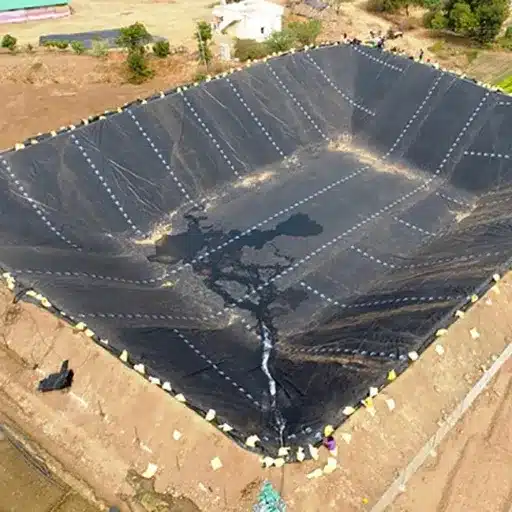
Functionality of Geotextiles
Geotextiles are multi-functional materials that find applications in different industries due to their capability to not only improve but also prolong the life of infrastructural projects. Not only separating, filtering, reinforcing, draining and protecting, geotextiles are also playing a vital role in the stability of structures in both civil and environmental engineering fields through their support of separation.
Preventing mixing of different soil layers is one of the most important functions of geotextiles, and this is especially important in road construction where the different layers of a road need to be kept intact. Geotextiles also act as very good filters; they allow water to pass through while retaining soil particles thus preventing erosion. For instance, non-woven geotextiles are widely used under riprap or in trench drains for better water control.
Functionality of Geomembranes
Geomembranes are widely known as impermeable materials and are used mainly for retention purposes. Their usage spans from waste management through water resources, mining, and agriculture to the medical industry. Moreover, their main feature is to provide prevention, thus stopping the flow of liquids, gases, or pollutants into the environment. Geomembranes are made of materials like high-density polyethylene (HDPE), linear low-density polyethylene (LLDPE), and polyvinyl chloride (PVC). They have all the character traits of being strong, resistant to chemicals and flexible.
One of the major uses involves landfills, where geomembranes come into play as liners which retain leachate and stop the infiltration of contaminated groundwater. Market analysis shows that the landfill sector is responsible for a large portion of the geomembrane market, which is indicative of the worldwide trend towards more secure and sophisticated waste management systems. In addition, the mining sector is dependent on geomembrane functioning as a secure barrier in heap leach pads and tailings dams from where the already contaminated not-yet-extracted ground areas are kept and thus the less pollutive areas are protected.
Installation Processes

Installation of Geotextiles
1. Site Preparation
Before the geotextile installation, the site must go through detailed examination and clearing so that the geotextile material will not be damaged by any debris, sharp objects, or even irregular surfaces. The site will be ready for the geotextile foundation after grading has been done so that the foundation is stable and even.
2. Unrolling and Placement
Geotextiles come in rolls and normally they should be unrolled according to the directions given by the project design. An example of this is in road construction where the geotextiles are placed longitudinally to traffic flow. It is important to do the placement in a way that avoids folds or wrinkles since these will affect the material’s performance.
3. Overlap Specifications
In order to avoid discontinuity, geotextiles usually need an overlap between the sections that are next to each other. The common practice in the industry regarding overlap is 12-18 inches (30-45 cm), but areas with loose or sandy soils might require bigger overlaps to cover the possible shifting or displacement under the load.
Installation of Geomembranes
1. Preparation and Site Inspection
Prior to installation, the site should be thoroughly inspected and prepared. The grading of the subgrade should be done to provide a smooth surface and should be compacted and cleared of sharp objects, debris, or irregularities which could damage the geomembrane. Studies indicate that subgrade protrusions above 0.5 inches significantly increase the occurrence of puncturing or stress damage to the geomembrane by as much as 40%. However, proper installation of the geomembrane and the associated risks can be minimized by adequate preparation as it will be a stable base for the deployment.
2. Deployment Process
Geomembranes are commonly utilized. Unrolling and positioning over the chosen surface is done by means of specialized equipment that prevents stretching or tearing. The deployment is done in seasons with suitable weather conditions, to avoid wind placement problems and to ensure that extreme temperatures would not affect the material’s flexibility and handling. Research shows that the installation temperature range of 50°F to 104°F (10°C to 40°C) gives the geomembrane the best performance during deployment.
3. Seaming and Welding
Seaming methods like thermal fusion or extrusion welding are the ones that bring together geomembrane panels. Properly executed seams guarantee a watertight barrier that is very important for applications such as landfill liners or wastewater containment. Quality assurance processes like destructive and non-destructive testing of seams play a vital role. Research has found that poorly welded seams account for 80–90% of geomembrane failures in containment systems.
Cost-Effectiveness
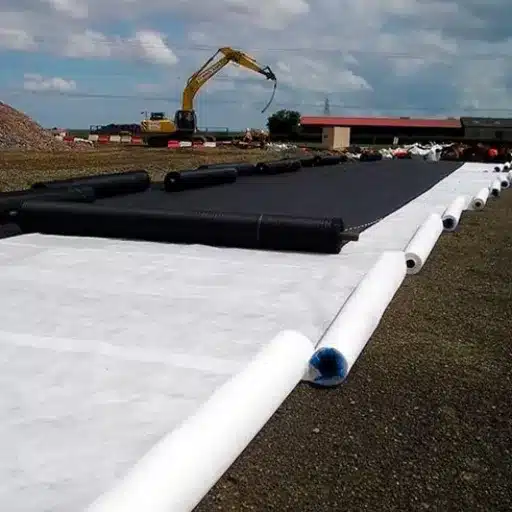
Cost Analysis of Geotextiles vs. Geomembranes
The cost of geomembranes, which are usually made from high-density polyethylene (HDPE), polyvinyl chloride (PVC), or linear low-density polyethylene (LLDPE), is higher than that of geotextiles per square foot. To be more specific, the price of HDPE geomembranes is around $0.50 to $0.80 per square foot on average, whereas PVC geomembranes’ price can be between $0.75 and $1.20 depending on thickness and quality. The total investment is further increased by the installation cost, which includes labor and equipment, due to the precision and expertise needed.
Conversely, geotextiles, which are mostly made from woven or non-woven polypropylene or polyester, are less expensive. Geotextile price lists mostly range from $0.10 to $0.60 per square foot with variations according to type and specifications. Their easy installation and versatility for use in separation, filtration, and drainage, among other things, are what contribute to their economy in large-scale projects.
| Material Type | Cost Range (per sq ft) | Material Composition |
|---|---|---|
| HDPE Geomembrane | $0.50 – $0.80 | High-Density Polyethylene |
| PVC Geomembrane | $0.75 – $1.20 | Polyvinyl Chloride |
| Geotextiles | $0.10 – $0.60 | Polypropylene/Polyester (Woven/Non-woven) |
Long-term Financial Implications
When looking at the long-term financial implications of using geomembranes versus geotextiles, one must take into account lifecycle costs, maintenance, and the projected lifetime of the product. In spite of the high upfront installation cost, geomembranes offer great impermeability and resistance to degradation caused by the environment. Research has shown that the average life of well-installed geomembranes can be more than 20-30 years. That greatly cuts down the company’s expenses for replacement and maintenance. Besides, the resistance of geomembranes to chemical exposure often results in the selection of such materials in landfills and wastewater treatment projects where the risk of contamination is high.
Meanwhile, geotextiles are generally less costly at the beginning because of their lower material and installation costs. For projects involving separation, filtration, or soil stabilization without the need for total containment, they are still the cheapest option. On the flip side, geotextiles are likely to need more frequent maintenance or replacement, especially in areas that are stressed or exposed to harsh conditions. The industry reports, in fact, assert that the replacement cycles for geotextiles lie between 5 and 15 years, depending on usage and environmental factors.
| Comparison Factor | Geomembranes | Geotextiles |
|---|---|---|
| Average Lifespan | 20-30 years | 5-15 years |
| Initial Cost | Higher | Lower |
| Maintenance Frequency | Lower | Higher |
| Long-term Value | Better for containment | Better for separation/drainage |
Reference Sources
-
BPM Geosynthetics
- Title: What Is The Difference of Geotextile vs Geomembrane
- Why Reliable: This source provides a comprehensive comparison of geotextiles and geomembranes, focusing on their applications, properties, and benefits in engineering and construction projects.
-
EcoGeoX
- Title: What is the Difference Between a Geotextile and Geomembrane Liner
- Why Reliable: EcoGeoX offers a detailed explanation of the differences between geotextiles and geomembranes, emphasizing their unique roles in groundwork and environmental applications.
-
Singhal Industries
- Title: Which Is Better For Your Project: Geomembrane or Geotextile
- Why Reliable: This source discusses the advantages and limitations of both materials, helping readers understand which is better suited for specific project requirements.
Frequently Asked Questions (FAQs)
What is the difference between geomembrane and geotextile?
Geomembrane and geotextile are two types of materials that differ mainly in their functions and characteristics. The former is generally a non-permeable material, meaning that it is meant to stop the flow of liquids entirely, whereas the latter consists of permeable materials allowing the flow of water but still providing filtration and separation. The functions of geomembranes are mostly in liners for landfills or canals, while geotextiles are considered for drainage and soil stabilization.
What is a geotextile and how is it different from a geomembrane?
A geotextile can be defined as a geosynthetic material consisting of synthetic fibers which may be woven or nonwoven. It is used to improve soil properties, provide filtration, and enhance drainage. Conversely, a geomembrane, often made from materials such as HDPE or PVC, is mainly employed for waterproofing and containment purposes, acting as a barrier to liquids.
What are the uses of geomembrane and geotextile in civil engineering?
The application of both geomembrane and geotextile in civil engineering is extensive. The former is a common choice for liners in landfills, reservoirs, and canals to prevent seepage and maintain waterproofing. In contrast, the latter is assisting in soil stabilization, erosion control, and drainage systems, performing filtration while being permeable to water.

